A New Leaf from ‘Otto Ege Manuscript 8’
August 15, 2015 in Manuscript Studies, Photographic Exhibition
Processional for Nuns for Palm Sunday
Budny Handlist, Number 4
From a ‘Gradual’
Produced in England, circa 1275
In our series on ‘Manuscript Fragments’ within our blog (see its Contents List), we continue to examine some leaves dispersed into various collections, both private and public, through the methods of Otto F. Ege. Earlier posts on those leaves considered Lost and Foundlings, A New Leaf from ‘Otto Ege Manuscript 41’, and A New Leaf from ‘Otto Ege Manuscript 61’. [Update: See also More Leaves from ‘Otto Ege Manuscript 51’. Now we focus on a musical leaf for liturgical performance with Singing Nuns on a high holy day.
[First published on 15 August 2015, with updates. First, we note the lecture on the work of reconstructing the original manuscript by Alison Altstatt: Re-membering the Wilton Processional: A Manuscript Lost and Found. Wonderful discoveries! We are delighted to learn about them.
More recently, we note the announcement that (after earlier sales from that collection), the residue of manuscript materials in the possession of Otto F. Ege’s family has been purchased by the Beinecke Library at Yale University. The transfer encourages the anticipation of more revelations about surviving leaves from the dispersed manuscripts, perhaps also this one.
And now, we celebrate the publication of Alison’s ground-breaking article which gathers the remnants of the manuscript and sets them into their historical and codicological context. ‘Re-Membering the Wilton Processional’ is available online via Project Muse. Congratulations, Alison! We look forward to learning more, as your explorations continue.
More updates! Lisa Fagin Davis reports the discovery of An Otto Ege Treasure Trove in Maine and its purchase by Colby College. Her blogpost includes details about the Wilton Processional, with reference notably to Alison’s work of reconstructing it.]
 We unveil another detached leaf, privately owned and previously unknown, from one of the very many manuscripts which Otto F. Ege (1888‒1951) dismembered for dispersal, mostly by sale. In this case, the book figured among his various musical manuscripts, for which Ege displayed a marked preference. Some of its leaves were dispersed individually as specimens in the different sets of his early Portfolio edition of Fifty Original Leaves from Medieval Manuscripts, Western Europe, XII‒XVI Century, issued between 1930‒1950.
We unveil another detached leaf, privately owned and previously unknown, from one of the very many manuscripts which Otto F. Ege (1888‒1951) dismembered for dispersal, mostly by sale. In this case, the book figured among his various musical manuscripts, for which Ege displayed a marked preference. Some of its leaves were dispersed individually as specimens in the different sets of his early Portfolio edition of Fifty Original Leaves from Medieval Manuscripts, Western Europe, XII‒XVI Century, issued between 1930‒1950.
The nature of this Portfolio, its edition, its methods and date-range of assembly, and the present locations of some of its 41 or more sets (counting those both numbered and unnumbered), are described in our recent posts on
There you can find references and links to many useful studies, still in progress, about Otto Ege’s manuscripts, the discovery of their remnants, and their piecemeal recovery, at least in virtual form. A dedicated website for the Portfolio gives a list of their current locations so far identified (now up to 30 out of the 40+ sets), and shows images of the leaves (usually both recto and verso, with transcriptions and/or identifications for some of their texts) for 13 of the Portfolio sets. Some collections show their own images, either in addition or instead.
In this infamous Portfolio, each of the separate specimens of single leaves from the single musical manuscript appeared as Leaf Number 8, framed in a mat, provided with a uniform printed descriptive caption (shown below), and placed in the company of single leaves from other manuscripts similarly presented. Other parts of the same book circulated differently, as the so-called ‘Rogue Leaves’ or groups of leaves (‘Residuals’) discharged from Ege’s corral, like the one now at the University of Illinois. The New Leaf is one such ‘Rogue’.
Specimens of ‘Leaf Number 8’ in the Original Leaves Portfolio + ‘Rogue Leaves’ from the Same Book = ‘Ege Manuscript 8’
The leaf belonged to the manuscript which came to be distributed in isolated specimen leaves as Leaf 8 within the Portfolio. Among the ‘Ege Manuscripts’ identified in Scott Gwara’s Handlist of Manuscripts Collected and Sold by Otto F. Ege — Appendix VIIII (pages 106‒107) in Otto Ege’s Manuscripts (2013) — this manuscript is Ege Manuscript Handlist Number 8 (page 119), attributed to ‘England, c[irc]a 1275’. In my Handlist of Medieval and Early Modern Manuscripts, Documents, and Early Printed Materials, the New Leaf from that manuscript is Number 4.
And so, here we focus on the New Leaf from Ege Manuscript 8, with a view to illustrate it and to set it briefly into context. ‘Briefly’ is the operative word.
Short and Sweet
After the post on Lost and Foundlings, which reproduces a detail of the leaf, I was contacted by a researcher preparing an article on the source manuscript and its dispersed leaves, with the observation that this new leaf brings the total of Known Leaves from that volume to 33. Learning of her research, I have decided to report briefly about the leaf here, and to leave the fuller examination to her care. And so, this post refrains from examining as many features as does the report of the newly discovered leaf (in a different collection) from Ege Manuscript 41.
[Update: With her permission, I can report the news of her lecture reporting her work, to take place on 9 September 2015 at the University of Northern Iowa. The news release gives some details about her ongoing research and its results. Have a look! Re-membering the Wilton Processional: A Manuscript Lost and Found. We eagerly look forward to learning more from her detailed study of the book as a whole.]
The Nature of the Leaf
With somewhat uneven contours, the vellum (or parchment) leaf measures circa 182 × 120 mm, with a written area of circa 140 × 90 mm. It carries single columns mostly in 9 lines of text accompanied by four-line staves with Square Notation for Gregorian Chant. The dislocated leaf presents the now-disconnected part of a sequence of texts pertaining to the musical performance of the liturgy for Palm Sunday, a Movable feast in the liturgical calendar. Its rubricated directions, entered by the original scribe, specify the active participation of nuns.
As written, the leaf turns the hair side (still flecked with some partly-sheared hair follicles) of the animal skin to the verso, with the whitish flesh side placed onto the recto. While still within the manuscript, that sheet of skin retained a greater extent than the 20th-century depredations allowed it to preserve, in their determination to reduce it to a leaf alone for singular distribution. An ‘orphan’ of sorts.
Cutting it Short
The sharp, partly jagged edge of the inner margin preserves, in part, traces of the original ‘gutter’ of the leaf as it stood in the book, as well as some stitching stations of the former binding(s). The uneven cuts which severed the leaf from its companions for the Ege-headed distribution imply that it was formerly attached to a conjoint leaf, forming a folded pair nested in the original volume.
The jagged cuts on the New Leaf probably indicate that the severance for the purpose of distributing leaves occurred while the manuscript was disbound, with loose leaves and bifolia. As not infrequent for detached ‘Otto Ege Leaves’, the uneven trimming manifests some signs of haste.
Closing In
Two different types of mounting tapes for the detached leaf itself have left their traces as well. They show that the leaf has been mounted in 2 different orientations during its travels (unknown) from the manuscript and its arrival into its present ownership. Neither type of mounting tape resembles the characteristic ‘Ege mount’, so other agents than Ege appear to have been involved in the frame-up.
- The gummy traces of linen tape placed in more-or-less horizontal strips along the top and bottom edges of the verso attest to one approach, mounting the leaf to its windowed mat with the recto facing the viewer.
- The broader patch of transparent tape affixed somewhat askew to the top margin of the recto attests to a different approach, turning the focus of attention toward the verso.
Either way, the former frames not only would have hidden from view the other (whatever) side of the leaf, but also would have masked all the edges of the leaf. So much for zeroing in and thereby obscuring or hiding parts of the evidence.
Too much can be lost in that misguided way. We prefer to zero in on all sides. We gladly see that, with permitted conservation, the leaf has been ‘liberated’ from those partial, limited views. And so, now we turn to a glimpse of the leaf in full.
Say it in Song
Breaking off mid-sentence and mid-song at both ends, at both the top of the recto and the bottom of the verso, the leaf carries the last lines of one notated chant, all of the next three, and the first lines of another. These musical texts are accompanied by the rubricated directions for the singers, voices, motions, and ‘players’ in the liturgical performance.
The text on the leaf presents the words for the chants, with their musical notation on staves above their own lines, in a vertical pairing of notation for words and music. Both the words and the square notation are written in dark brown ink.
Here I omit a description of the forms of notation, to allow for further analysis by others. (Meanwhile, here is a useful guide for How to Read Square Notation.) Ege’s printed Caption for his Leaf 8 (shown and transcribed below) offers some pointers.
Lay It All Out
As for features of the layout, some observations may be useful. Without going into details about the script, either, I mention a few features which contribute to deciphering its flow and transcribing its contents.
Words divided between lines sometimes employ slanted hyphens at the line-endings, sometimes not (as variously in lines r1 and 2). Punctuation marks ending phrases, passages, and most of the rubricated directions (but not v8) take the form of medial points (·), raised above the baseline of the letters. The letter y is surmounted by a dot (line v2). The letter i is sometimes distinguished from u by having a surmounted slash (í), as in the formations filíum, obuía, and perhaps nubíila [sic] ending the recto.
With its slash, that formation nubíila (correctly nubila) could result from a partial ‘save’ of a misspelling-in-progress. Several signs of this kind indicate imprecision, and perhaps also haste, in inscribing the text, musical notation, and decorative embellishments in the pen-flourishing. These mistakes are noticeable, but not really appalling. (So they are not the worst in the transmission of medieval manuscripts. That’s another story, with some world-class competition.)
Open-Ended
Rendered in thin red lines, the staves are open-ended at their right-hand end, and sometimes also at the left. The more-or-less vertical extensions of penwork from the enlarged opening initials of the chants which stand at the beginnings of lines (lines r2, r6, v7) serve to close the left-hand ends of some staves.
Those opening initials are blue, standing the full height of the stave-plus-text for each line of music. These initials have decorative red penwork or pen-flourishes formed in somewhat unsteady lines.
The penwork fills the inner fields of the initials with curvilinear ornament and extends along most or all of the column into the upper and/or lower margins with looped flourishes, striped bands of more-or-less parallel lines, and the outlines of various forms of foliate ornament, and, on the recto, an animal-headed terminal. The ornament includes a fleur-de-lys turned to the side (opposite line v5) and the terminal of, apparently, a goat-like head facing upward and seen mostly in profile, but with a pair of horns.
The view of the head cheerfully, if perhaps incongruously, seems to double up a profile and a 3/4 view. Not the most expert artist’s work, and it may challenge our powers of decipherment, but the animated terminal carries a lively conviction as it engages with the words and music which form the core of the message in the column of text, staves, and notation. More about these animations later.
Written in red pigment by the same scribe as the text, the directions or rubrications stand either within the line of the words in the cases of single-word directions (cantrix for ‘female singer’ in r7 and sacerdotes for ‘priests’ in v8) or in closely-spaced sets of 3-line instructions beside or between the staves. On the recto, the direction fits fully between the end of one chant (line 3) and the beginning of the next, thereby adding an extra series of lines (call them ‘r4a–c’) in the column customarily of 9 lines. On the verso, the directions stand to the right of the end of each chant, in a set of lines which fills the space beside the stave and text, usually with their path mostly cleared of stave-lines.
The Songs and Their Stage Directions
The leaf carries portions of 2 truncated chants at its beginning and end (at lines r1 and v9). These partials proceed or follow 3 full chants, plus the rubricated directions (written in red) introducing those chants. The textual divisions between leaves and between recto and verso of this leaf are indicated here by a forward slash (/). The span of the texts on the leaf are indicated by their line number on recto and verso (‘r’ and ‘v’), as lines 1–9 corresponding with the staves + text. The variants to that numbering introduced by the 3-line rubrications have a subset of a–c (as in lines ‘v1a–c’ which stand beside line 1 of musical notation concluding the previous chant).
The texts function partly as a dialogue between the priests and nuns. They commence within the last part of a chant from the Gospel of Matthew, Chapter 26, which spans lines r1‒3. There follow an instruction and its chant, which completes its course on line v1. Directly there follow the instructions and chants for two more chants, as well as for the beginning of another (lines v8‒9).
1) . . . Gospel of Matthew, Chapter 26:18‒19
[ . . . tempus meum prope est apud te] / facio Pascha cum discipulis meis et fecerunt discipuli sicut preseparat eis dominus et parauent Pascha
2) Duo clerici cum ad tentorum· quae inde afferunt feretrum quod interpretatur osanna· inchoatur alta uoca·
(‘Two clerics, while they then carry these things to the tentorum (“tent”), which is to be understood as a “bier” (feretrum), Hosanna is begun in a high voice.’) A modern emendation in pencil adds a superscript x between clerici and cum, as a cue, and supplies the alternate form eunt (‘[they] go’) in cursive script in the outer margin.
Occurrunt turbe·
cantrix·
cum floribus et palmis redemptori obuiam et uictori triumphati digna dant obsequia filium dei ore gentes praedicant et in laudem Christi uoces tonant per nubula [or í with an otiose second minum as a first-intended u] / hosanna·
3) Deinde quatuor sacerdotes ante tapetum versis quae dicuntur uultibus ad osanna·
(‘Then: four priests before the tapetum (“hanging”, “covering”), with faces turned, these [things] are said up to Hosanna.’)
En rex uenit mansuetus tibi syon filia mistica humilis sedens super animalia auem uenturum iam predixit lectio prophetica·
4) Sex sorores stantes contra eos dicantur·
(‘Six sisters [“nuns”] standing opposite them; let them say [that is, “sing”]:’)
Salue quem Iesum testatur plebs Hebrorum obuia cum palmis tibi clamans uerba salutis·
5) Sacerdotes (male ‘Priests’)
Hic · est qui te uenit tinctis Bosra / [uestibus, in sola sua formosus . . . ]
Approaches to Processionals for Palm Sunday
There exist vast and specialized bodies of research on the surviving witnesses to medieval music, medieval chants, medieval devotional practices employing music (religious and/or secular), and patterns of manuscript transmission up to the early modern period and beyond, in the British Isles and elsewhere. A few cues and clues set the stage for a broader setting for the New Leaf, both in its manuscript and its world of song and ceremony.
The brief indications here do not aim to interfere with a fuller expert study of Ege Manuscript 8 as a witness for the relevant genres, but simply seek to affirm how much a study of that kind is needed. Contextual evidence for the different chants on the New Leaf leads me to consider them in a different sequence than their order upon it.
I. England in the Thirteenth Century and Earlier
Item 2) Occurrunt turbae cum floribus
The CANTUS Database for Recorded Latin Ecclesiastical Chant lists 43 cases so far for the antiphon Occurrunt turbae cum floribus . . . per nubila hosanna (‘ID 004107’) among the medieval chants for Palm Sunday (Dominica in Palmis). This witness adds another attested case.
The sources include another 13th-century English witness: Worcester Cathedral, Manuscript F.160 (olim 1275). That manuscript, nearly complete (354 folios with ‘one lacuna’), is a ‘compendium of liturgical material’, including a monastic Antiphoner, Processional, Hymnal, Kyriale, Gradual, and other elements, made for Worcester Cathedral circa 1230 (with 14th-century additions). Its chants are indexed here. Its Antiphoner and Processional are reproduced in facsimile freely online in Palaeographie musicale, 12 (1922); its set for the Procession for Palm Sunday spans folios 103v‒105v. A worthy relative.
Earlier cases of the antiphon Occurrunt turbae occur in some Ordines (or Rites) for the antiphons in Holy Week in Anglo-Saxon England and elsewhere, as tabulated conveniently by Jesse D. Billett, The Divine Office in Anglo-Saxon England, 597 – c. 1000 (2014), for example in Table 8.4 (pages 295–298) and Table 8.5 (pages 299–300), with lists of its position in the recorded sequences for Palm Sunday in several surviving witnesses, both English and Continental.
The witnesses include the set of 5 reused endleaves in London, British Library, Royal MS 17 C.xvii, folios 2–3 + 163–136, a fragmentary Benedictine ‘Breviary’ made probably in the last quarter of the 10th century in an unknown location, perhaps at or via Abingdon Abbey (according to Billett’s detailed examination on his pages 252–285). That dislocated fragment contains the set of chants, readings, and prayers for the Divine Office during the two weeks leading up to Easter, with Palm Sunday included. Another worthy, even older, relative.
And so, the use in England (among other places) of this Antiphon for Palm Sunday already well before the time of production of Ege Manuscript 8 demonstrates a currency — but not a uniformity or unanimity (of course) — with which the New Leaf from it conforms in certain respects. Other clues extend both in these and other directions chronologically.
Item 1) Prima autem azymorum (?)
The partial version of the chant from Matthew 26 on the New Leaf presumably represents, in its original form, another case of the antiphon Prima autem azymorum (‘ID 203956’) of Matthew 17 onwards. The CANTUS database so far lists 2 cases, which include that same renowned Worcester Compendium and an Iberian witness.
Already could these glimpses indicate that the Leaf represents a Procession for Palm Sunday which was not exactly mainstream? During its own time, that is, and at least as the medieval and later witnesses can be seen to survive or find recognition? Also, is it fair to ask if the female component itself might be a component for non-mainstream? I look forward to learning more about these and related issues.
II. Sed Contra (‘And Yet’)
The 3 other chants or partial chants on the New Leaf apparently do not have relatives recorded in CANTUS. In connection with The Digital Image Archive of Medieval Music, a few cases in the 15th century are reported (page 53, Reference Numbers 0177 and 0178).
And yet, versions of them appear — sometimes in the same consecutive order — for the Palm Sunday Procession in some other sources for polyphonic ritual music devoted to Holy Week from the British Isles in the late medieval and early modern periods. They include versions of the Sarum Processional (Rouen, 1508) and the Sarum Missal, recording the Rites for liturgical ceremonies for the Use of Sarum, or Salisbury Cathedral.
As here, using the Item numbers for my ‘inventory’ of texts on the leaf itself simply as indicators:
3) En rex uenit mansuetus tibi . . . prophetica
Sometimes this specimen, introducing the Prophet into the Palm Sunday discourse, is called, by its first and last words, the ‘En prophetica’ verse.
4) Salue quem Iesum . . . salutis
5) Hic est qui uenit tinctis Bosra . . . , albeit worded somewhat differently on the New Leaf.
Also, these texts occur, as Allenson’s ‘Inventory’ Numbers 2, 3, and 5, within a sequence of music for Palm Sunday (and some other ritual occasions) recovered in paper fragments – perhaps of the mid-16th century — from a Scottish parish church and its school, probably at Inverness. They are published by Stephen Allenson, ‘The Inverness Fragments: Music from a Pre-Reformation Scottish Parish Church and School’ (1989), Plate I, Table II (page 7), Appendix I (‘Inventory’), page 20, Appendix II (‘Transcriptions and Reconstructions’), pages 24–26, and Plate I.
In reporting and reconstructing the sequence of music on those fragments, Allenson surveyed the surviving sources and the scholarly assessments for the evidence for Palm Sunday (pages 7–9 and note 14, with a useful list of references). According to the evidence then available to him, he observed that ‘the most important addition to the standard Sarum processional material contained in this [Scottish] source is the so-called “En propheta” verse’, which, ‘wherever it is attested, seems to have been primarily a feature of parochial worship’. All the same, he reflected, while the evidence of transmission is scarce, there are some suggestions that its use may have occurred in England ‘long before’ the first mention of the piece in English cathedral statutes in the mid 16th century (pages 8–9).
The New Leaf appears to offer a missing link. Intriguing. If the other portions of the music in Ege Manuscript 8 likewise provide exceptional records of 13th-century Processional (and other) practices for Singing Nuns, it seems a great shame that Otto Ege’s dismemberment of the manuscript robbed it of taking its rightful place in full among the witnesses to musical liturgical practices for women in the High Middle Ages.
Occasional Practice
To recap. This leaf forms part of a set of Processional hymns or chants. As a leaf only on its own, its contents imply former companion leaves to either side, before and after it, to complete the set of texts for the specific liturgical occasion. In this case the text pertains to the liturgical ceremony for Palm Sunday.
With its text beginning abruptly within one chant, moving on to some more chants, and then breaking off abruptly within another, the leaf resoundingly proclaims its former place between leaves for the same occasion, at least. Not to mention those for other occasions for the full liturgical year, with both Fixed and Movable Feasts, in a recurring cycle, as required by a set Rite for the order of public worship, including the Mass and Divine Office. In England in the 13th century, the Use of Salisbury, or Sarum Rite, established for the Cathedral and Diocese of Salisbury in the 11th century, had become prevalent throughout much of England, albeit with many variations, and also with other Rites (or elements of them) in place alongside them and/or instead of them. Did I mention that it could be complicated?
The rhythm of occasions across the year and from year to year involves some liturgical occasions occurring on the same day every year (as with the feast day assigned to a particular saint), and others occurring on calendar days which vary from year to year. Palm Sunday, marking the Entry to Jerusalem, moves from year to year, along with the full series of liturgical occasions pertaining to Easter. Those occasions extend from the preparations for Easter during the 40 days of Lent, which culminate in Holy Week (starting with Palm Sunday and leading to Good Friday with the Crucifixion), to the 50 days of Eastertide, which begin with Easter Sunday (or Resurrection Sunday) and extend, via the Ascension, to Pentecost. The Easter cycle forms one of the most important, if not the most important, defining moments for Christianity as a religion.
Dialogues between Nuns and Priests, Palm Sunday Included
A different sort of dialogue, but possibly less harmonious, between nuns and priests or canons affected the fate of another significant witness to Palm Sunday Processionals in the 13th century. ‘A quarrel between the Benedictine nuns from the convent of the Frauenmünster and the chapter of canons from the of Zürich contributed to the saving of a thirteenth-century ordo‘ written in 1260 by Konrad von Mure (died 1281) and now preserved in Zürich, with meticulous directives for various liturgical processions, including their routes, gestures, and chants, as well as alternate routes in the case of impediments of various kinds — for example the weather or road obstructions. Its directives for Palm Sunday, giving alternatives apparently from newer and older practices, are examined by Elizabeth Lipsmeyer in ‘The Liber ordinarius by Konrad von Mure and Palm Sunday Observance in Thirteenth-Century Zürich’, Manuscripta, 32 (1988), especially pages 141–145. Although pertaining to a different region altogether, and to different layers of practice, that witness conjures up for our imaginations a potential range of sights, sounds, textures, and people engaged in the processions in practice on the day and over the years during the same century as the production and early use of the New Leaf and its book.
Processionals Little and Large
In their manuscript settings, processional chants could occur as separate collections or as part(s) in books of the Mass and/or readings for the revolving series of Hours in the Divine Office. With music, the modern terms of Antiphonary and Gradual, for the most part, refer to books of the Office and Mass respectively. Surveys of these and other forms of medieval liturgical books, including the evidence from England, appear, for example, in Terence Bailey, The Processions of Sarum and the Western Church (Toronto, 1971); and Richard W. Pfaff, The Liturgy in Medieval England: A History (Cambridge, 2009).
Yet the terms for the various genres of liturgical texts and books vary significantly across the centuries — partly as they continued to evolve, partly as modern terms do not always display consistency in their descriptions of the medieval forms, and partly as the books themselves could blend or confound genres. To put it mildly, the relevant evidence and studies relating to it are vastly dispersed.
To put it simply, the genre(s) of the original form of Ege Manuscript 8 would depend upon its texts as a whole. As with, say, its relative the Worcester Cathedral Compendium (described above), it might have contained a combination, including, say, those 3 genres and more, according to precise musicological inspection. For now, we concentrate upon its Processionals. In any case, whatever company they might keep (or not) in a given volume, the shapes of Processionals in medieval manuscripts were variously portable ̶ like this small-format version ̶ or bulky and imposing in larger formats.
Already I have encountered such issues regarding several forms of liturgical books in medieval England, as described in the Illustrated Catalogue, Volume I, page lxii and the entries for its Numbers 30, 31, 39, 43, 44, and 48, addressing manuscripts at Corpus Christi College, Cambridge. Including some with music or added music, they are MS 470 (the Corpus Winchester Troper); MS 146 (the Samson Pontifical); MS 163 (a Romano–Germanic Pontifical adapted for Use in a Female Community); MS 391 (the Portiforium of Saint Wulfstan), a thick, portable compendium of a Psalter and a Breviary, for the daily use by an eleventh-century bishop as he traveled around his diocese; MS 422 Part II (the Red Book of Darley), similarly portable; and MS 270 (the ‘Missal’ of Saint Augustine’s Abbey, Canterbury), which started life as a Sacramentary and became partly converted to a Missal on site through later alterations, including a Gradual.
Note that some manuscripts could start life for use by one sort of religious community (male, female, episcopal, parochial, etc.) and might undergo transformations variously as they were turned over to use by another community, as that original community itself underwent transformations, as rites for liturgical practice acquired changes, and so on and on. Significant in some witnesses are the signs for female use, as with the alterations in Corpus MS 163. In some cases those signs reside only or mainly in the feminine forms of the Latin (or vernacular) for the text, either in its original form and/or in its alterations.
Ege Manuscript 8, insofar as we can glimpse its traces, exhibits both those types of signs. Portable, too. Moreover, its interest on some other leaves in religious females among the characters of its drama, and not only as singers, appears to reflect a calculated appeal to its audience.
According to Ege
Ege’s printed caption for the specimen leaves of Number 8 in his Portfolio gives some limited information. To Whit:
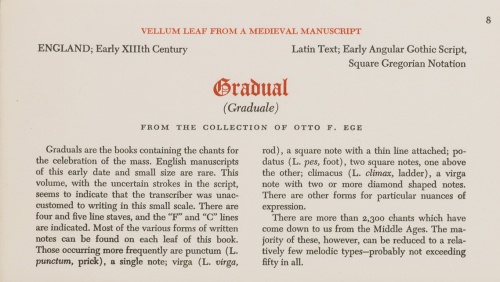
Otto Ege’s Printed Caption for Portfolio Leaf 8. From the Collection of The Public Library of Cincinnati and Hamilton County. Reproduced by permission
The caption explains that
Graduals are the books containing the chants for the celebration of the mass. English manuscripts of this early date and small size are rare. This volume, with the uncertain strokes in the script [emphasis mine], seems to indicate that the transcriber was unaccustomed to writing in this small scale [ditto]. There are four and five line staves, and the ‘F’ and ‘C’ lines are indicated. Most of the various forms of written notes can be found on each leaf of this book. . . .’ [There follows a list of some of the forms of notation, allowing for variants, as applicable.]
The New Leaf exhibits the four-line stave approach in the first of the 2 variants which Ege reported. In all the leaves from his Manuscript 8 that I have seen so far, none has 5-line staves, only 4-line. Perhaps he meant a longer view of the development of musical notation as such over the centuries, not viewed in the manuscript itself. It wouldn’t be the first time that one of his captions conflated the particular and a general view, without distinguishing between them in the interests of clarity.
However, it is not impossible that Otto Ege’s caption in his Portfolio for the detached leaves from the same manuscript, calling it a ‘Gradual’/‘Graduale’, just might carry some useful weight as a reflection or repetition of an earlier, say medieval, term accompanying this very book. Or not — given Ege’s known tendencies for imprecision and omissions in recording relevant information, as shown for Ege Manuscript 41. In many cases, if not all (the Jury is still Out), he manifestly adapted some terms to fit his purposes of dispersal and generalized instruction, before casting the ‘Orphaned’ leaves (my term) into the worlderness (not a typo, in case you were wondering).
Animal Instinct
The script on the New Leaf seems mostly competent but not elegant; there are several errors of transcription (as with nubíile); and the scope for freedom allowed above all in the embellishment. The amateurish, but charming, animated terminals for various of the decorated initials reinforce the view that the production of the manuscript involved, to some extent, a measure of relatively untrained, but imaginative, expression in the calligraphic department.
Why should that be strange in a little book designed for portability and usability in performances upon a variety of occasions? This is not a magnificent manuscript designed to lie, reverently, upon a sturdy lectern. Its place seems more appropriate in the hands of holders. It has different claims, as well as origins.
The rough quality of some of the parchment leaves, even though diminutive in size, indicate a source of writing materials not of the highest order. (No offense!)
For example, the uneven slit which descends from the top of the Kent State University leaf (reproduced here) arose during the preparation of the skin, say through a slip of the knife, or while it remained on the animal. The holes alongside the slit remain from the stitching, afterwards removed, which held the tear together for the process of stretching and drying the leaf in its conversion from skin to parchment — a process which, by its very nature, requires drying the skin while stretched taut. The dirty, darkened inner edge along the gutters of many leaves show wear and tear, among various signs of use which the book received over time.
Somehow, given these features, I continue to reflect that the whimsical animated terminals for some of the terminals of decorated initials (described below) perhaps manifest an empathy or awareness of sorts for the creatures which gave their very skins for the grounding of the book itself. Not all manuscripts to survive from the medieval period provide such hints, if such they are, but they may reveal an acknowledgement of the world both within and outside the particular liturgical occasion and its sonorous performance.
Perhaps related, the Response Quatuor animalia ibant et . . . egrediens for Saint Matthew the Evangelist straddling the recto and verso of the Kent State University leaf itself celebrates the ‘Four Animals’, which represent or embody the Four Evangelists. This chant stands between those which sing the praises of a ‘king’s daughter’ Beata Edytha or ‘Blessed Edith’ (ending on r1–4) and the Archangel Michael.
Omitted by Ege
Omitted by Ege is the evidence, facing him on its very pages, of a manuscript prepared for the use of religious females, and not only adapted for them. Nuns in fact, not laity. The female forms in the rubrics as written by the original scribe on the New Leaf alone — cantatrix (‘songstress’) and sorores (‘sisters’, that is, ‘nuns’) — demonstrate such aims. There is not evidence enough on this leaf alone (as far as I know) to indicate which community or communities were served by the book in its history of use and portability.
Attention to some female ‘leads’ in the cast on some other identified leaves in the manuscript — variously as characters in the settings, voices in the dialogue, and subjects of devotion — appears to represent, and give voices to, the interests of the devout audience/participants in the liturgical practices as expressed in and through the book. At least it is clear that, with its rubricated directions and set of songs in the form of polyphonic liturgical chants with Square Gregorian notation, this manuscript counted on the active participation of nuns.
All the Single Ladies
The directions for the ceremony and cues to the relevant singers for the given chants on the New Leaf suffice to establish that, from its creation, the manuscript was intended for the use of nuns in the company of their priests and ‘clerics’. Some of the other surviving leaves from the manuscript do not make that clear. Some leaves carry alterations, as on the verso of the leaf in Set 27 at the University of South Carolina, which indicate such intentions, or revised intentions, for particular portions. On their own, those alterations would sustain an interpretation that the manuscript was, at least, revised, for use by nuns.
The whole story is rather more complex. Together with the original indications, the alterations demonstrate that the book continued in use by nuns over some time, or time and again.
Processionals for Nuns
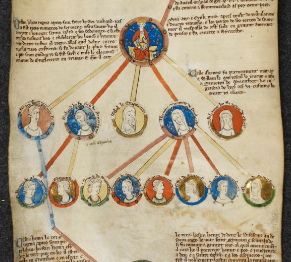
‘Seinte Edith’ (second from the left in the first row) takes her place among the children of King Edward I. © The British Library Board, Royal MS 14 B V, Membrane 6, detail. Reproduced by permission.
Processionals designed for, or used by, nuns in England survive mostly from later dates. The evidence and transmission are complex, and scholarly dedication to their analysis is both intense and specialized. Expert studies of the Divine Office and liturgical practice, including Palm Sunday Processionals, continue to add to the treasury of knowledge for medieval English and related habits, male as well as female.
Some surviving Processionals and related genres are listed by Terence Bailey, The Processions of Sarum and the Western Church (Toronto, 1971), pages 79–80, dividing their groups by date-range and country. Those for England include some later cases which pertain to nunneries (as with numbers 79, 83, and 86). Ege Manuscript 8 deserves to be added to the list.
Notable among the recognized surviving Processionals for nuns from England are the Bridgettine Processionals, that is, for the Bridgettine (or Birgittine) Order. Several survive from Syon (or Sion) Abbey, founded in 1415. An account of those books, their use by the nuns, and their fates is given by Christopher de Hamel, ‘The Medieval MSS of Syon Abbey, and Their Dispersal’, in Syon Abbey: The library of the Bridgettine Nuns and their Peregrinations after the Reformation (Otley, 1991), pages 85–87. One might imagine, in a world of fuller surviving evidence, the possibility of such a ‘biography’ for the life, performances, travels, and reminiscences of the original Ege Manuscript 8.
Many studies continue to examine the manuscripts and their contexts, as more research, discoveries, and analysis illuminate medieval English practices for the singing of nuns, on many occasions and in many places. Unveiling more of the evidence, as it becomes identified, surely benefits the process of recognition as a whole.
Put a Sing On It
Among the remnants (only some of which I have seen in person, print, or online), a few more-or-less fixed points can set the scene. Samples among the remnants readily available for view online reveal portions of the Processional from the rest of Holy Week, Easter, and Eastertide. There are also, for example, Litanies for saints and antiphons for some saints, including English saints.
Some surviving leaves, on their own, carry rubrications which specify the occasion. Such is the case with the direction In uigilia ascensionis ad missam off[icium] (‘For the Office of the Mass on the Vigil of the Ascension’) on the Massey College leaf, designating the the Vigil of the Ascension, that is, the eve before the Feast of the Ascension, a feast day observed traditionally on the 40th day of, or after, Easter Sunday. That occasion, customarily falling on a Thursday, is observed now more often on the next Sunday instead. Which allows for some confusion nowadays about when properly to observe the Vigil, but that is a different story.
Such variability in the application of dates and occasions for the assignment of chants to one occasion or another throughout the centuries, including within a single century in a single country — as for the sequences of chants for Palm Sunday in 13th-century England — makes it advisable to refrain from assigning a particular occasion to some of the dispersed leaves from Ege Manuscript 8, until clearer indications come to light. For now, without a fuller set of specific directions, it does not make sense to declare which Occasion was the one intended for each case unless stated therein. Here, as said, is a sampling:
I. From Holy Week Through Eastertide
PALM SUNDAY
Budny, Handlist, Number 4 (You are Here)
THE REST OF HOLY WEEK (including Maundy Thursday, Good Friday, and Holy Saturday)
Portfolio Set 32. University of Colorado at Boulder
Set 22. Cleveland Public Library, with part of a liturgical drama about the Three Maries
EASTER SUNDAY AND EASTERTIDE
Set 13. University of Minnesota, with the antiphons
- Sedit angelus at sepulchrum (ID 004858) on recto
- Crucifixum in carne laudate (ID 004858a) on verso
Set 30. Denison University, with part of Quem quaeritis o tremulae (the discovery of the Resurrection at Easter)
Set 37. Case Western Reserve, with parts of Ad Felicem episcopum de Pascha carmen (‘A Song about Easter to Bishop Felix [of Nantes]’),
setting to music the poem composed by Venantius Fortunatus (circa 530 – circa 600/609 CE)
Rogue Leaf: Gwara, Handlist, Number 8.1. University of Illinois, with the Antiphon to the Virgin at the end of Compline in Easter season
OCTAVE OF EASTER
Set 27. University of South Carolina, with the end of Fortunatus’ Easter poem and part of Mark 16.
VIGIL OF THE ASCENSION (The Night Before 40 Days After Easter)
Set 17. Massey College, The University of Toronto
[Update: With thanks to Alison Altstatt for her generous willingness to share information about her discoveries, it is possible to add this leaf to the list of links
ASCENSION and beyond
Rogue Leaf(?). University of Iowa
with the end of one chant and all of both Ite in orbem universum et and Versus Paraclitus autem spiritus on its verso]
II. For Those and Other Occasions As Well
KYRIE
Set 25. University of Saskatchewan
SAINTS & LITANIES
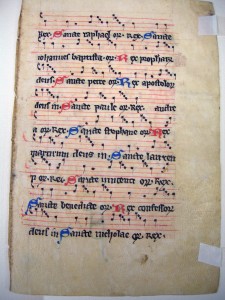
Recto of Leaf 8 in Portfolio Set 9. From the Collection of The Public Library of Cincinnati and Hamilton County. Reproduced by permission.
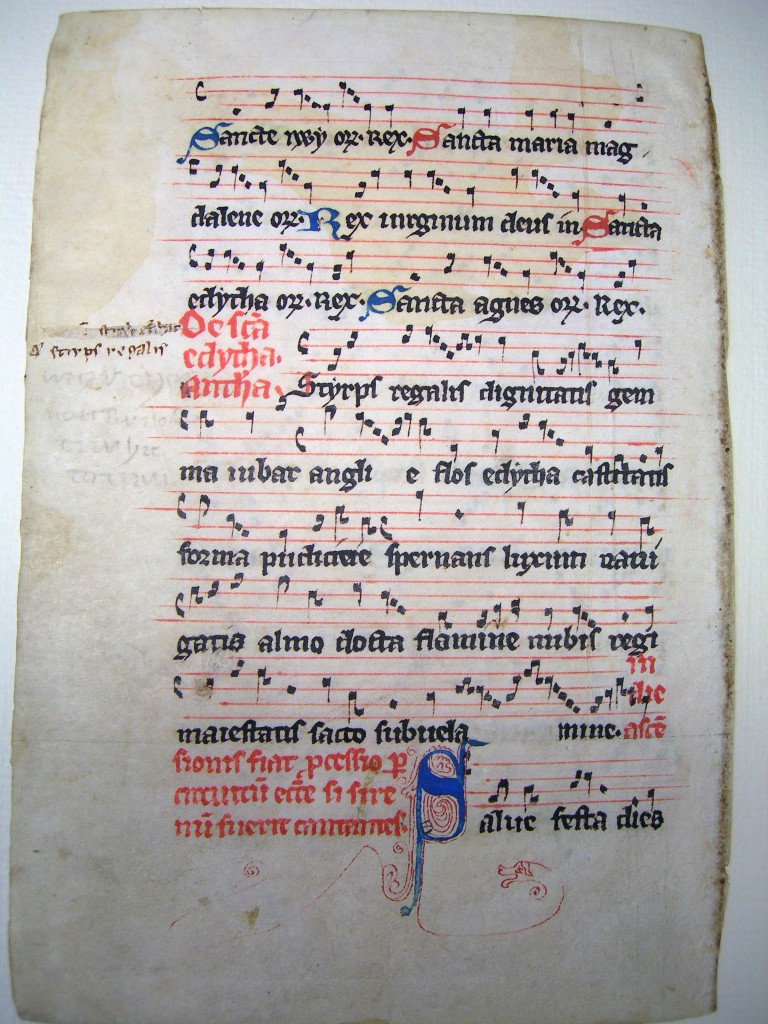
Verso of Leaf 8 in Portfolio Set 9. From the Collection of The Public Library of Cincinnati and Hamilton County. Reproduced by permission.
Set 5. Ohio University, including a list of 9 Female ‘Virgin’ Saints on the verso
Set 9. The Public Library of Cincinnati and Hamilton County (reproduced here by permission), including archangels, apostles, confessors, and virgin saints, with the full antiphon
Styrps regalis dignitatis gemma . . . sub uelamine for Saint Edith (De Sancta Edytha), that is, Saint Edith of Wilton (961‒984) of Wilton Abbey in Wiltshire
Set 15. Kent State University (reproduced above by permission), including evangelists and the conclusion of a chant naming that same ‘Beata Edytha’
Set 35. Rochester Institute of Technology‘Saint Thomas, Martyr’ = Thomas Becket (circa 1118 – 1170) , Archbishop of Canterbury (1162–1170).
An interest in some English saints, female saints, and at least one English female saint is evident in the choices for celebration, remembrance, and song.
Singled out for attention, and more than once, among the remnants which I have seen, is the Anglo-Saxon saint Edith (Old English Eadgyth, Latin Editha/Ediva etc.), daughter of King Edgar (943–975), who ruled from 959 to 975. Fascinating tidbits about her life and afterlife can be found here. One of my favorites among images of this saint is her painted ‘bust portrait’ in a roundel within a royal genealogical ‘tree’ along with other members of her family on a late 13th-century roll. Another is her 3/4-length upright figure, carrying a book (Yes!) and gesturing in blessing, on a wax seal made from a 10th-century seal matrix, affixed to a charter of 1372 from her abbey (British Library Harley Charter 45 A36). Used as the seal of Wilton Abbey until the 16th century, the matrix (known from its impressions) carries her name and probably belonged to her, for use as her personal seal.
As far as I know, the antiphon in Edith’s praise from Ege Manuscript 8 does not appear to be otherwise recorded. Would that count as Off the Record? Or, Off the Charts? Worthy of induction, perhaps, into the Haul of Fame? (Pun and Fun Intended.)
Suspended Animation, or, Facing the Music
On some leaves, the pen-flourishes extending from the decorated initials end in the unskilled drawings of whimsical creatures or part-creatures. Mostly (so far as I have seen), these animated terminals represent beings seen in profile, but some turn their heads in other views.
The creatures belong to the human, animal, and perhaps avian realms, as well as to some hybrid mixtures from more fanciful realms. Usually they show their heads-with-necks, as on the New Leaf. Its neck wears a band-like collar, springing from a sort of tapered pedestal, rather like a trophy head. Some necks are open-ended, as on the Kent State University verso with its antiphon for Saint Edytha. That head adopts a cheerful or eagerly beseeching expression, with opened jaws and a drooping ear or down-turned horn. The inner contour of its neck curls into a rounded clockwise coil, while the terminals of the pen-flourishes on the opposite side of the tail of the same initial coil in the opposite direction. Such details convey a sense of motion and improvisation which add a lively sense of play to the ensemble.
Some of the animated terminals comprise fuller figures, as with the upward-looking hybrid creature looking up toward the right in the lower margin on the Denison University verso. (That page also has a catchword, with a cue for the opening word on the next quire, and the confirmation that this leaf formerly concluded a quire.) Seen in profile, this monoped, which resembles a perky duck-like creature, wears a pointed hood. Perhaps a pointed comment?
Sometimes a single page has more than one creature, and these creatures can appear to communicate with one another, albeit quizzically. On the University of South Carolina verso, a bearded, short-haired human head and a goat-like head watch each other, perhaps ominously. Looking downward, the man’s head is seen in 3/4 view, with closed lips, while the animal, seen in profile, looks upward with parted jaws. Wary of dinner, maybe?
These whimsical, animated terminals are manifestly the creations of a single designing hand. I think they are delightful.
A bonus is that these creations are unmistakable. With their ad-hoc, unstudied, and playful variations, they instantly proclaim the work of a single scribal artist with an idiosyncratic style. Combined with the musical texts for the cycle of the liturgical year (at least in part?), these critters may help readily to spur the recognition of other leaves from the dismembered book. We look forward to welcoming their return to the Virtual Fold.
Coda
The rarity of the surviving evidence, all things considered, after the losses across the centuries of so very many materials, or the wretched reduction of many more to fragments dispersed to the winds, makes it clear that Ege Manuscript 8 may form an important resource, especially insofar as it can be glimpsed more fully, as its fragments become recognized, virtually reconstructed, and set into context.
Carefully identified, reconstructed, and analyzed, its evidence would offer the promise of clearer knowledge about Processionals (as well as other ritual ceremonies) with female, as well as male voices, in 13th-century England. Likewise, its signs of alterations, use, and abuse over time attest, albeit in fragmentary or piecemeal ways, to the habits applied to existing liturgical books after they entered into practice, revision, rejection, and revival across the centuries, including this one.
Perhaps you know of other leaves from this manuscript? We would be glad to learn of their survival.
*****
We thank the staff of the libraries of Kent State University, The Public Library of Cincinnati and Hamilton County, and The Lilly Library at the University of Indiana University, Bloomington, for advice, for images, and for permission for reproduction of materials in their collections. Among them are James Mainger at the Cincinnati Public Library, Amanda Faehnel at Kent State University, and Nile Arena and Zach Downey at the Lilly Library.
I also record with thanks the advice which the late Michel Huglo, our former Associate, gave when he examined the leaf itself several years ago.
[Update: Thanks also to Alison Altstatt, who generously shares information about her research work!
And now, with permission, we include a photograph to record a happy, impromptu meeting of fans of the manuscript in May 2016 at the Reception sponsored by the Research Group on Manuscript Evidence and the Index of Christian Art at the 51st International Congress on Medieval Studies.]
*****
Next stop: Another specimen in the Handlist.
Update: You can now see the list of our blogposts on Manuscript Studies.
*****

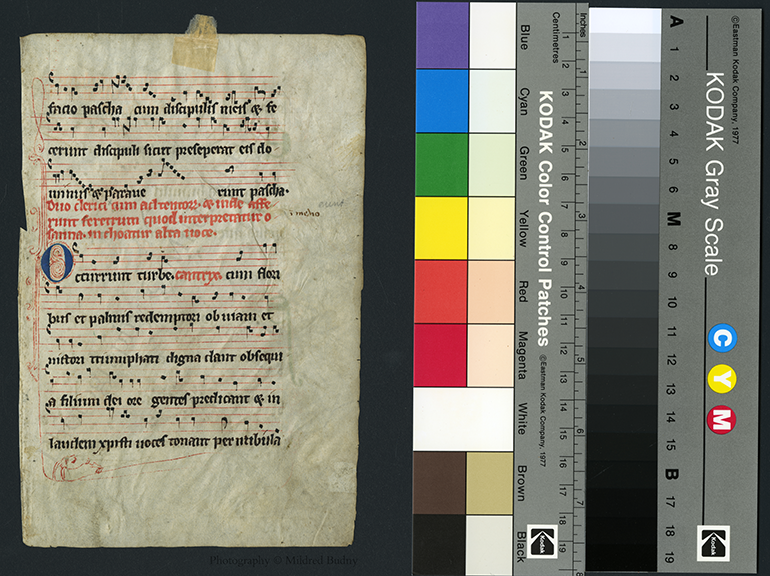
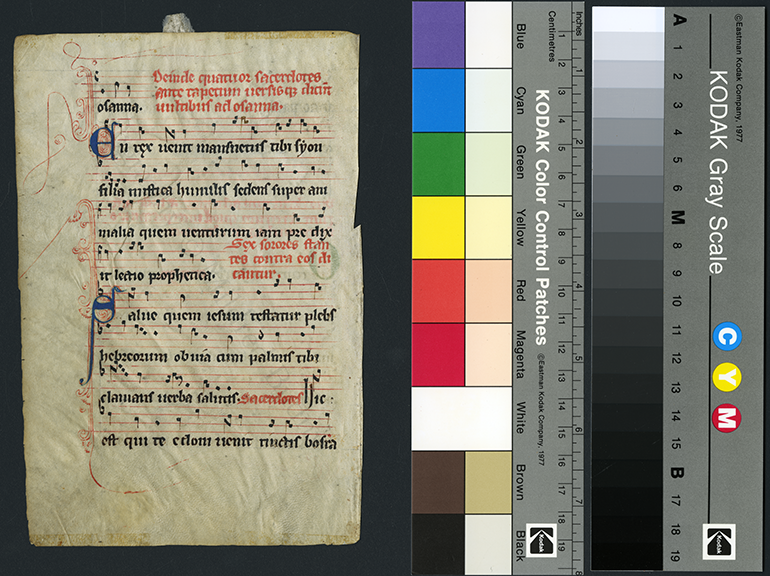


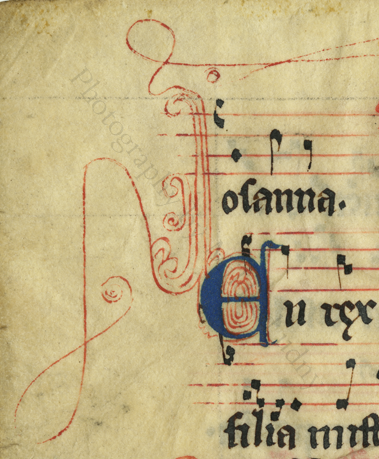
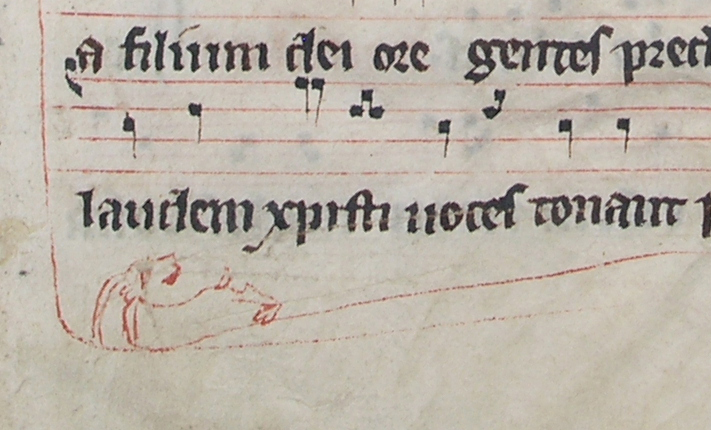

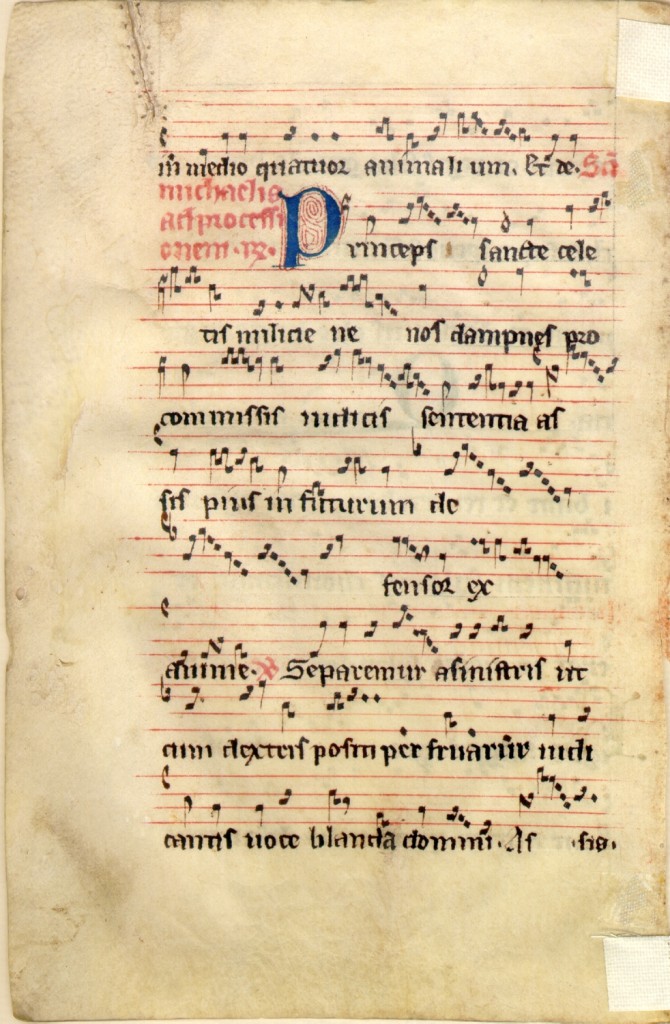
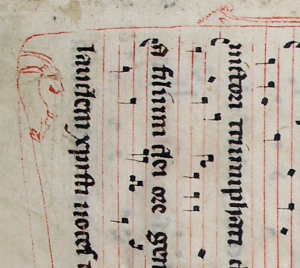

Happy to learn of more discoveries about the manuscript. With the publication of Alison Alstatt’s article on Re-Membering the Wilton Processional (June 2016), we can observe the revelation of further survivors identified. All to the good.
It’s wonderful that you are getting ideas from this article as well as from
our dialogue made at this time.
http://xxx.com recently posted…http://xxx.com